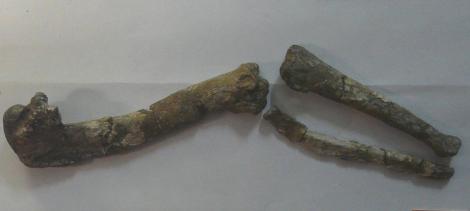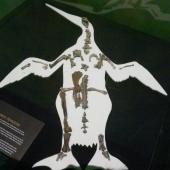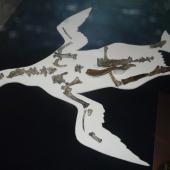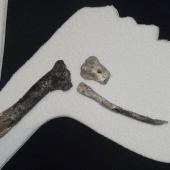Waipara penguin
Muriwaimanu tuatahi (Jones, Ando & Fordyce, 2006)
Order: Sphenisciformes
Family: Incertae sedis
The Waipara penguin is the second oldest penguin fossil known. It was described from three associated part skeletons recovered from early Late Paleocene (60-58 million-year-old) sedimentary deposits along the Waipara River, North Canterbury. It was a medium- large penguin, similar in size to a yellow-eyed penguin, and was described at the same time as the (larger and older) Mannering’s penguin. Both were originally placed in genus Waimanu, which is considered basal to all other penguins. Basal penguins differed from later penguins in their long, slender beaks and relatively longer legs. The three Muriwaimanu specimens are some of the oldest well-preserved Neornithine birds, and indicate that penguins split from related forms before the end of the Cretaceous epoch. There is ongoing debate over whether these ancient birds should be included in the same family as modern penguins.
The holotype (OU 12651) is held in the Geology Museum, University of Otago and comprises an associated part skeleton including skull fragments, incomplete mandible, cervical vertebrae, ribs, synsacrum, a furcula, coracoids, proximal right scapula, right humerus, distal left humerus, an ulna, a radius, and proximal right femur. The two paratypes are part skeletons held in Canterbury Museum (CMNZ zfa 33 and 34). The tarsometatarsus was 65 mm long, compared to 78 mm for Mannering’s penguin.
Waimanu is Māori for water bird, with Muriwaimanu meaning 'after Waimanu', as the fossils come from younger strata than those of Waimanu. The species name means ‘first’ in Māori, as the holotype was the first specimen found of those initially placed in genus Waimanu.
Weblinks
http://fossilpenguins.wordpress.com/2010/01/30/waimanu-the-first-penguin/
References
Fordyce, R.E.; Jones, C.M. 1990. Penguin history and new fossil material from New Zealand. Pp 419-446 in Davis, L.S. & Darby, J.T. (eds) Penguin biology. San Diego, Academic Press.
Jones, C. M.; Mannering, A. 1997. New Paleocene fossil bird material from the Waipara Greensand, North Canterbury, New Zealand. Geological Society of New Zealand miscellaneous publication 95a: 88.
Mayr, G.; De Pietri, V.L.; Love, L.; Mannering, A.A. & Scofield, R.P. 2018. A well-preserved new mid-paleaocene penguin (Aves, Sphenisiformes) from the Waipara Greensand in New Zealand. Journal of Vertebrate Paleontology 37: 6, e1398169. doi: 10.1080/02724634.2017.1398169
Slack, K.E.; Jones, C.M.; Ando, T.; Harrison, G.L.; Fordyce, R.E.; Arnason, U.; Penny, D. 2006. Early penguin fossils, plus mitochondrial genomes, calibrate avian evolution. Molecular Biology and Evolution 23: 1144-1155.
Recommended citation
Miskelly, C.M. 2013 [updated 2022]. Waipara penguin. In Miskelly, C.M. (ed.) New Zealand Birds Online. www.nzbirdsonline.org.nz
Waipara penguin
- Breeding season
-
- Jul
- Aug
- Sep
- Oct
- Nov
- Dec
- Jan
- Feb
- Mar
- Apr
- May
- Jun
- Egg laying dates
-
- Jul
- Aug
- Sep
- Oct
- Nov
- Dec
- Jan
- Feb
- Mar
- Apr
- May
- Jun










